David Kappel
Utilizing dynamic sparsity on pretrained DETR
Oct 10, 2025Abstract:Efficient inference with transformer-based models remains a challenge, especially in vision tasks like object detection. We analyze the inherent sparsity in the MLP layers of DETR and introduce two methods to exploit it without retraining. First, we propose Static Indicator-Based Sparsification (SIBS), a heuristic method that predicts neuron inactivity based on fixed activation patterns. While simple, SIBS offers limited gains due to the input-dependent nature of sparsity. To address this, we introduce Micro-Gated Sparsification (MGS), a lightweight gating mechanism trained on top of a pretrained DETR. MGS predicts dynamic sparsity using a small linear layer and achieves up to 85 to 95% activation sparsity. Experiments on the COCO dataset show that MGS maintains or even improves performance while significantly reducing computation. Our method offers a practical, input-adaptive approach to sparsification, enabling efficient deployment of pretrained vision transformers without full model retraining.
STREAM: A Universal State-Space Model for Sparse Geometric Data
Nov 19, 2024Abstract:Handling sparse and unstructured geometric data, such as point clouds or event-based vision, is a pressing challenge in the field of machine vision. Recently, sequence models such as Transformers and state-space models entered the domain of geometric data. These methods require specialized preprocessing to create a sequential view of a set of points. Furthermore, prior works involving sequence models iterate geometric data with either uniform or learned step sizes, implicitly relying on the model to infer the underlying geometric structure. In this work, we propose to encode geometric structure explicitly into the parameterization of a state-space model. State-space models are based on linear dynamics governed by a one-dimensional variable such as time or a spatial coordinate. We exploit this dynamic variable to inject relative differences of coordinates into the step size of the state-space model. The resulting geometric operation computes interactions between all pairs of N points in O(N) steps. Our model deploys the Mamba selective state-space model with a modified CUDA kernel to efficiently map sparse geometric data to modern hardware. The resulting sequence model, which we call STREAM, achieves competitive results on a range of benchmarks from point-cloud classification to event-based vision and audio classification. STREAM demonstrates a powerful inductive bias for sparse geometric data by improving the PointMamba baseline when trained from scratch on the ModelNet40 and ScanObjectNN point cloud analysis datasets. It further achieves, for the first time, 100% test accuracy on all 11 classes of the DVS128 Gestures dataset.
State-space models can learn in-context by gradient descent
Oct 15, 2024Abstract:Deep state-space models (Deep SSMs) have shown capabilities for in-context learning on autoregressive tasks, similar to transformers. However, the architectural requirements and mechanisms enabling this in recurrent networks remain unclear. This study demonstrates that state-space model architectures can perform gradient-based learning and use it for in-context learning. We prove that a single structured state-space model layer, augmented with local self-attention, can reproduce the outputs of an implicit linear model with least squares loss after one step of gradient descent. Our key insight is that the diagonal linear recurrent layer can act as a gradient accumulator, which can be `applied' to the parameters of the implicit regression model. We validate our construction by training randomly initialized augmented SSMs on simple linear regression tasks. The empirically optimized parameters match the theoretical ones, obtained analytically from the implicit model construction. Extensions to multi-step linear and non-linear regression yield consistent results. The constructed SSM encompasses features of modern deep state-space models, with the potential for scalable training and effectiveness even in general tasks. The theoretical construction elucidates the role of local self-attention and multiplicative interactions in recurrent architectures as the key ingredients for enabling the expressive power typical of foundation models.
Weight Sparsity Complements Activity Sparsity in Neuromorphic Language Models
May 01, 2024
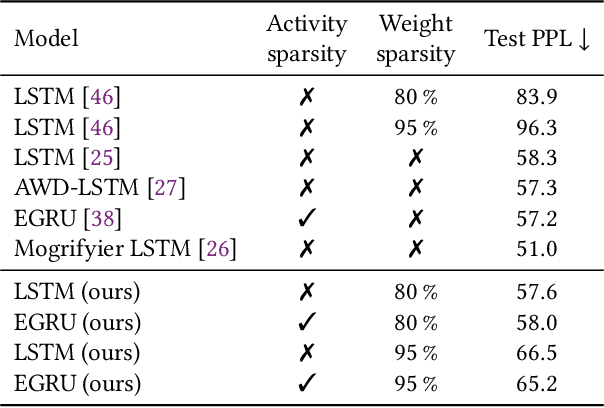
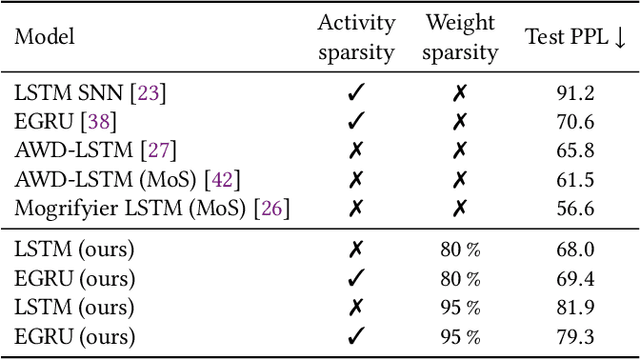
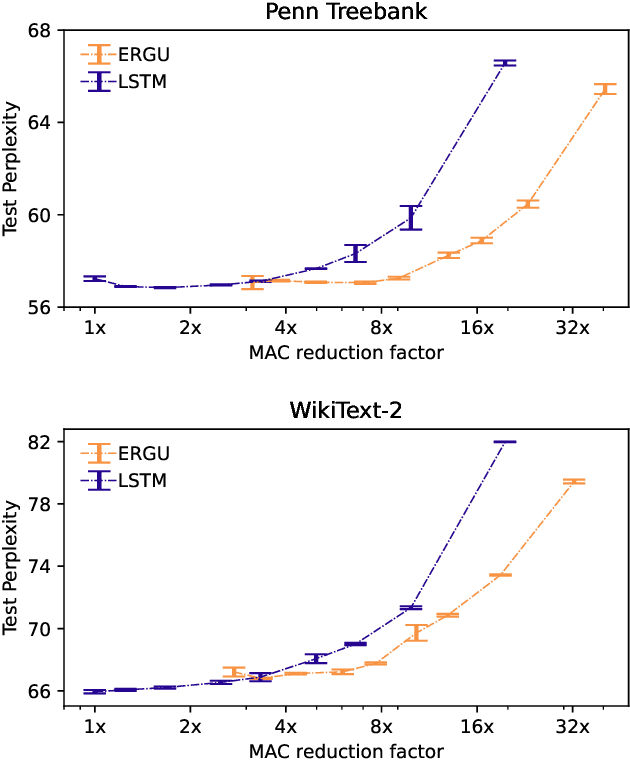
Abstract:Activity and parameter sparsity are two standard methods of making neural networks computationally more efficient. Event-based architectures such as spiking neural networks (SNNs) naturally exhibit activity sparsity, and many methods exist to sparsify their connectivity by pruning weights. While the effect of weight pruning on feed-forward SNNs has been previously studied for computer vision tasks, the effects of pruning for complex sequence tasks like language modeling are less well studied since SNNs have traditionally struggled to achieve meaningful performance on these tasks. Using a recently published SNN-like architecture that works well on small-scale language modeling, we study the effects of weight pruning when combined with activity sparsity. Specifically, we study the trade-off between the multiplicative efficiency gains the combination affords and its effect on task performance for language modeling. To dissect the effects of the two sparsities, we conduct a comparative analysis between densely activated models and sparsely activated event-based models across varying degrees of connectivity sparsity. We demonstrate that sparse activity and sparse connectivity complement each other without a proportional drop in task performance for an event-based neural network trained on the Penn Treebank and WikiText-2 language modeling datasets. Our results suggest sparsely connected event-based neural networks are promising candidates for effective and efficient sequence modeling.
Scalable Event-by-event Processing of Neuromorphic Sensory Signals With Deep State-Space Models
Apr 29, 2024


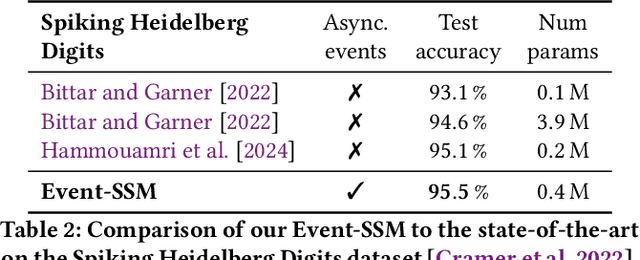
Abstract:Event-based sensors are well suited for real-time processing due to their fast response times and encoding of the sensory data as successive temporal differences. These and other valuable properties, such as a high dynamic range, are suppressed when the data is converted to a frame-based format. However, most current methods either collapse events into frames or cannot scale up when processing the event data directly event-by-event. In this work, we address the key challenges of scaling up event-by-event modeling of the long event streams emitted by such sensors, which is a particularly relevant problem for neuromorphic computing. While prior methods can process up to a few thousand time steps, our model, based on modern recurrent deep state-space models, scales to event streams of millions of events for both training and inference.We leverage their stable parameterization for learning long-range dependencies, parallelizability along the sequence dimension, and their ability to integrate asynchronous events effectively to scale them up to long event streams.We further augment these with novel event-centric techniques enabling our model to match or beat the state-of-the-art performance on several event stream benchmarks. In the Spiking Speech Commands task, we improve state-of-the-art by a large margin of 6.6% to 87.1%. On the DVS128-Gestures dataset, we achieve competitive results without using frames or convolutional neural networks. Our work demonstrates, for the first time, that it is possible to use fully event-based processing with purely recurrent networks to achieve state-of-the-art task performance in several event-based benchmarks.
Neuromorphic hardware for sustainable AI data centers
Feb 04, 2024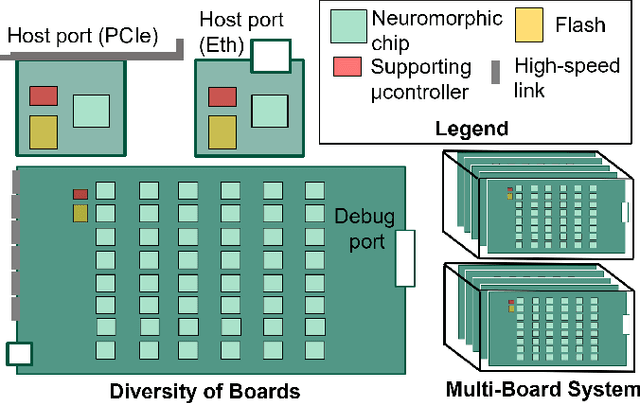
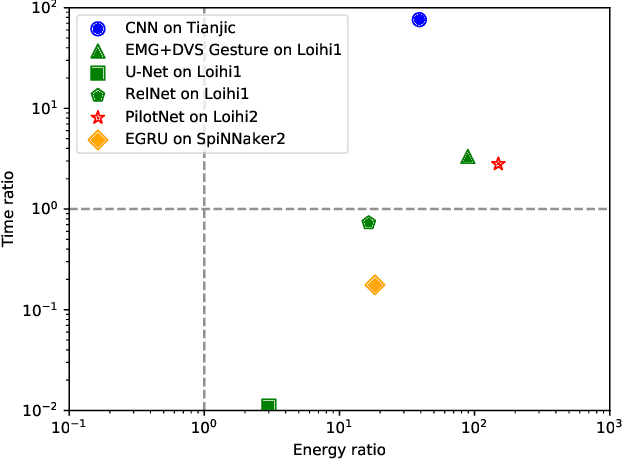
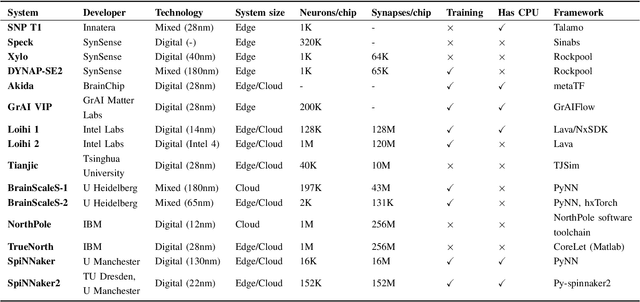

Abstract:As humans advance toward a higher level of artificial intelligence, it is always at the cost of escalating computational resource consumption, which requires developing novel solutions to meet the exponential growth of AI computing demand. Neuromorphic hardware takes inspiration from how the brain processes information and promises energy-efficient computing of AI workloads. Despite its potential, neuromorphic hardware has not found its way into commercial AI data centers. In this article, we try to analyze the underlying reasons for this and derive requirements and guidelines to promote neuromorphic systems for efficient and sustainable cloud computing: We first review currently available neuromorphic hardware systems and collect examples where neuromorphic solutions excel conventional AI processing on CPUs and GPUs. Next, we identify applications, models and algorithms which are commonly deployed in AI data centers as further directions for neuromorphic algorithms research. Last, we derive requirements and best practices for the hardware and software integration of neuromorphic systems into data centers. With this article, we hope to increase awareness of the challenges of integrating neuromorphic hardware into data centers and to guide the community to enable sustainable and energy-efficient AI at scale.
Language Modeling on a SpiNNaker 2 Neuromorphic Chip
Dec 14, 2023Abstract:As large language models continue to scale in size rapidly, so too does the computational power required to run them. Event-based networks on neuromorphic devices offer a potential way to reduce energy consumption for inference significantly. However, to date, most event-based networks that can run on neuromorphic hardware, including spiking neural networks (SNNs), have not achieved task performance even on par with LSTM models for language modeling. As a result, language modeling on neuromorphic devices has seemed a distant prospect. In this work, we demonstrate the first-ever implementation of a language model on a neuromorphic device - specifically the SpiNNaker 2 chip - based on a recently published event-based architecture called the EGRU. SpiNNaker 2 is a many-core neuromorphic chip designed for large-scale asynchronous processing, while the EGRU is architected to leverage such hardware efficiently while maintaining competitive task performance. This implementation marks the first time a neuromorphic language model matches LSTMs, setting the stage for taking task performance to the level of large language models. We also demonstrate results on a gesture recognition task based on inputs from a DVS camera. Overall, our results showcase the feasibility of this neuro-inspired neural network in hardware, highlighting significant gains versus conventional hardware in energy efficiency for the common use case of single batch inference.
Block-local learning with probabilistic latent representations
May 24, 2023Abstract:The ubiquitous backpropagation algorithm requires sequential updates across blocks of a network, introducing a locking problem. Moreover, backpropagation relies on the transpose of weight matrices to calculate updates, introducing a weight transport problem across blocks. Both these issues prevent efficient parallelisation and horizontal scaling of models across devices. We propose a new method that introduces a twin network that propagates information backwards from the targets to the input to provide auxiliary local losses. Forward and backward propagation can work in parallel and with different sets of weights, addressing the problems of weight transport and locking. Our approach derives from a statistical interpretation of end-to-end training which treats activations of network layers as parameters of probability distributions. The resulting learning framework uses these parameters locally to assess the matching between forward and backward information. Error backpropagation is then performed locally within each block, leading to `block-local' learning. Several previously proposed alternatives to error backpropagation emerge as special cases of our model. We present results on various tasks and architectures, including transformers, demonstrating state-of-the-art performance using block-local learning. These results provide a new principled framework to train very large networks in a distributed setting and can also be applied in neuromorphic systems.
EGRU: Event-based GRU for activity-sparse inference and learning
Jun 13, 2022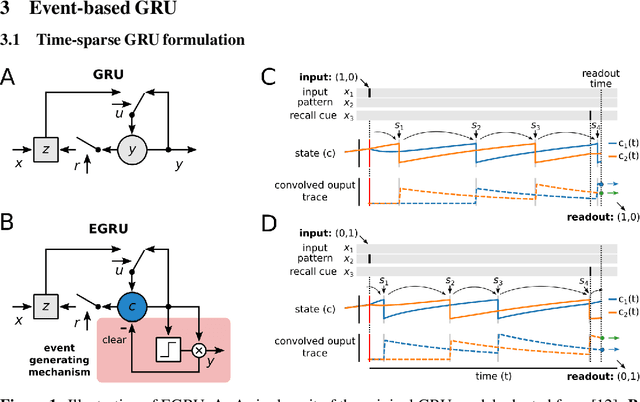

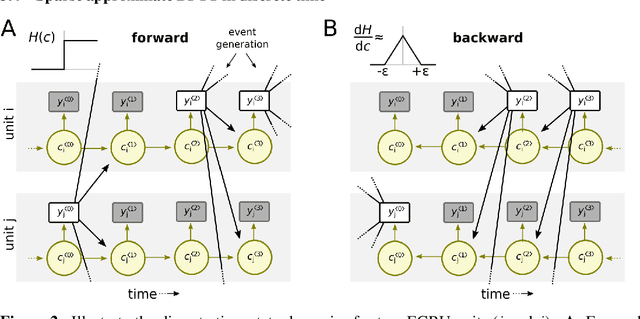

Abstract:The scalability of recurrent neural networks (RNNs) is hindered by the sequential dependence of each time step's computation on the previous time step's output. Therefore, one way to speed up and scale RNNs is to reduce the computation required at each time step independent of model size and task. In this paper, we propose a model that reformulates Gated Recurrent Units (GRU) as an event-based activity-sparse model that we call the Event-based GRU (EGRU), where units compute updates only on receipt of input events (event-based) from other units. When combined with having only a small fraction of the units active at a time (activity-sparse), this model has the potential to be vastly more compute efficient than current RNNs. Notably, activity-sparsity in our model also translates into sparse parameter updates during gradient descent, extending this compute efficiency to the training phase. We show that the EGRU demonstrates competitive performance compared to state-of-the-art recurrent network models in real-world tasks, including language modeling while maintaining high activity sparsity naturally during inference and training. This sets the stage for the next generation of recurrent networks that are scalable and more suitable for novel neuromorphic hardware.
Embodied Synaptic Plasticity with Online Reinforcement learning
Mar 03, 2020



Abstract:The endeavor to understand the brain involves multiple collaborating research fields. Classically, synaptic plasticity rules derived by theoretical neuroscientists are evaluated in isolation on pattern classification tasks. This contrasts with the biological brain which purpose is to control a body in closed-loop. This paper contributes to bringing the fields of computational neuroscience and robotics closer together by integrating open-source software components from these two fields. The resulting framework allows to evaluate the validity of biologically-plausibe plasticity models in closed-loop robotics environments. We demonstrate this framework to evaluate Synaptic Plasticity with Online REinforcement learning (SPORE), a reward-learning rule based on synaptic sampling, on two visuomotor tasks: reaching and lane following. We show that SPORE is capable of learning to perform policies within the course of simulated hours for both tasks. Provisional parameter explorations indicate that the learning rate and the temperature driving the stochastic processes that govern synaptic learning dynamics need to be regulated for performance improvements to be retained. We conclude by discussing the recent deep reinforcement learning techniques which would be beneficial to increase the functionality of SPORE on visuomotor tasks.
* 18 pages, 5 figures, published in frontiers in neurorobotics
 Add to Chrome
Add to Chrome Add to Firefox
Add to Firefox Add to Edge
Add to Edge